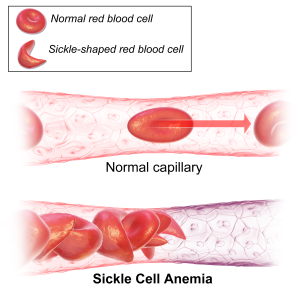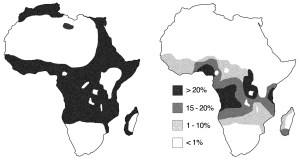9 Mutations, Examining Sickle Cell Anemia
Mutations
Mutations that occur during the translation of RNA into proteins can affect the coding sequence of a gene. These changes may take place in either the non-coding region, such as the promoter, or the coding region, where the actual protein sequence is established. Mutations in non-coding regions can impact how much, where, or when a gene is activated. In contrast, changes in the coding region can alter both the protein sequence and its expression during translation.
Within the coding region, there are a few classes of mutations that classify what change is being made. These names can be used to classify the severity of the change occurring as well. do not alter the resulting protein, thanks to the redundancy of the genetic code. For instance, both GAA and GAG code for the amino acid glutamate. These mutations are typically considered non-harmful. Missense mutations involve a single nucleotide substitution that results in a different amino acid. For example, if GAA (glutamate) mutates to GCA, it now codes for alanine, potentially affecting protein function. result in a premature stop codon (UAA or UGA), leading to truncated and usually nonfunctional proteins.
Codon table from – https://lmu.pressbooks.pub/conceptsinbiology/chapter/the-genetic-code/?preview_id=664&preview_nonce=e9d7228378&preview=true
A frameshift mutation is caused by an addition or subtraction of less than three nucleotides; the entire coding frame experiences a shift. Frameshift mutations do not result when insertions or deletions occur in a multiple of three, due to each amino acid being coded for in triplet. Removing or inserting an entire amino acid series will not fundamentally change any nucleotides behind it. These additions and subtractions, more specifically, are called insertions and deletions. An insertion results in a frameshift when 1 to 2 nucleotides are added to an existing series – such as UUA becoming GUU A. UUA normally codes for amino acid leucine, but after the insertion, this becomes GUU, coding for valine. All of the code downstream of this insertion will be altered.
Case Study: Sickle Cell Anemia
Sickle cell anemia is a well-known example of a disease caused by a genetic mutation. It affects around 8 million people globally. The disease results from a missense mutation in the HBB gene, which encodes beta globin, a subunit of the hemoglobin protein responsible for carrying oxygen in red blood cells.
In individuals with sickle cell disease, the codon GAG (coding for glutamic acid) is mutated to GTG, which codes for valine. This single amino acid substitution, glutamic acid (a negatively charged, hydrophilic residue) replaced by valine (a non-polar, hydrophobic residue), significantly alters the folding of the hemoglobin protein in the aqueous cellular environment.
As a result, affected red blood cells adopt a crescent or “sickle” shape rather than the typical round form. These misshapen cells are more rigid and sticky, contributing to blockages in small blood vessels. This can lead to painful episodes, organ damage, and other serious complications due to restricted blood flow.

Figure 1. Diseased and non-diseased red blood cell and capillary.
Sickle cell anemia is a genetic disorder, coded for by two HBB genes. A person with the disorder has the genotype SS, meaning they have two copies of the mutated HBB gene. A healthy individual has the genotype AA, with no mutated copies of the HBB gene.
The genotype AS is referred to as sickle cell trait possessing. An individual with this genotype is considered a carrier, and will usually not experience complications from their genotype unless extreme conditions arise from altitude, intense exercise, or dehydration. Uniquely, this carrier has an advantage over both the homozygous genotypes. Heterozygous individuals are less likely to acquire malaria than either homozygous individual due to the sickle cell making it more difficult for the malaria parasite to grow.

Figure 2. Map of malaria (left) versus sickle-cell trait (right) distribution in Africa.
Media Attributions
- Sickle_Cell_Anemia © BruceBlaus is licensed under a CC BY-ND (Attribution NoDerivatives) license
- Malaria_versus_sickle-cell_trait_distributions © Anthony Allison is licensed under a CC BY-ND (Attribution NoDerivatives) license
